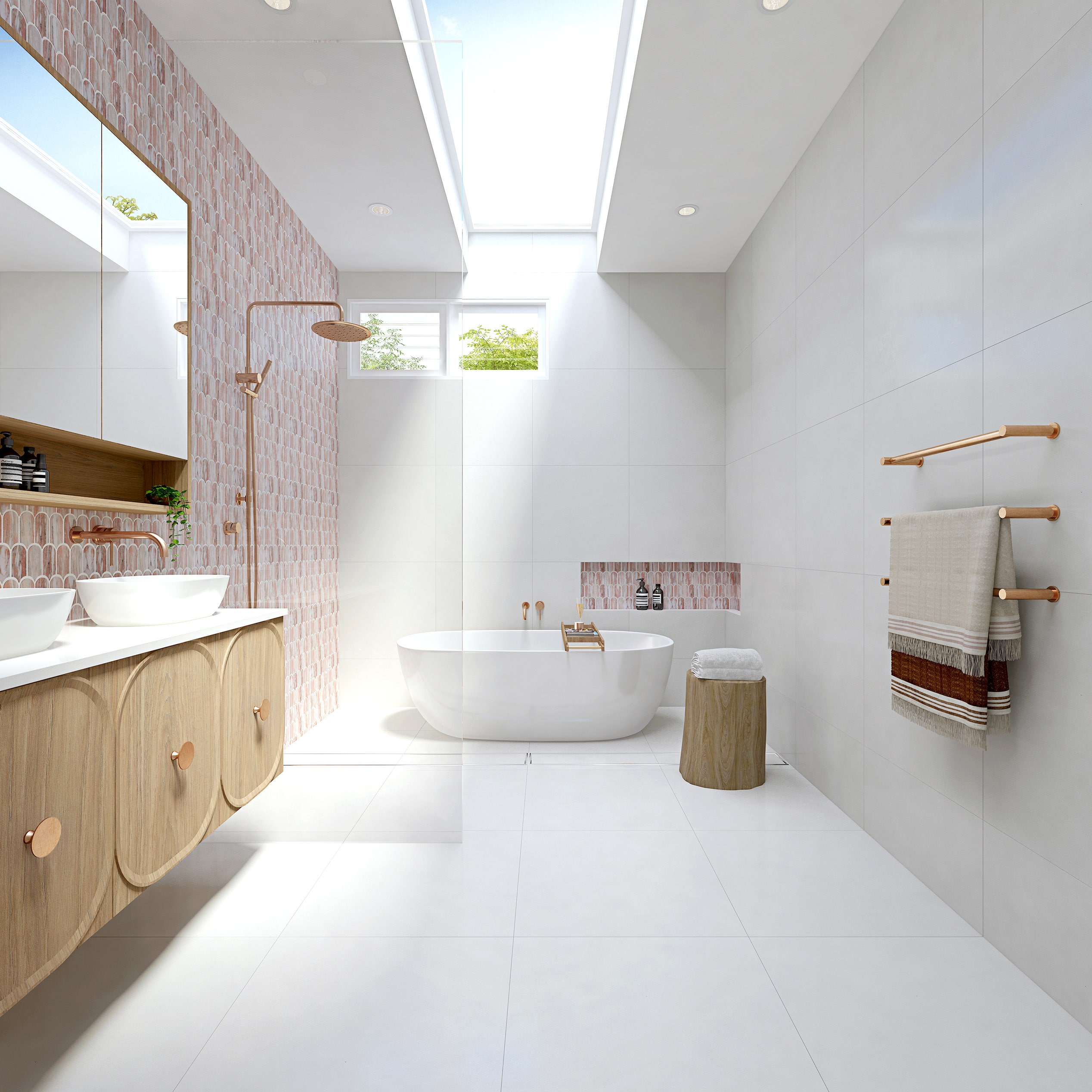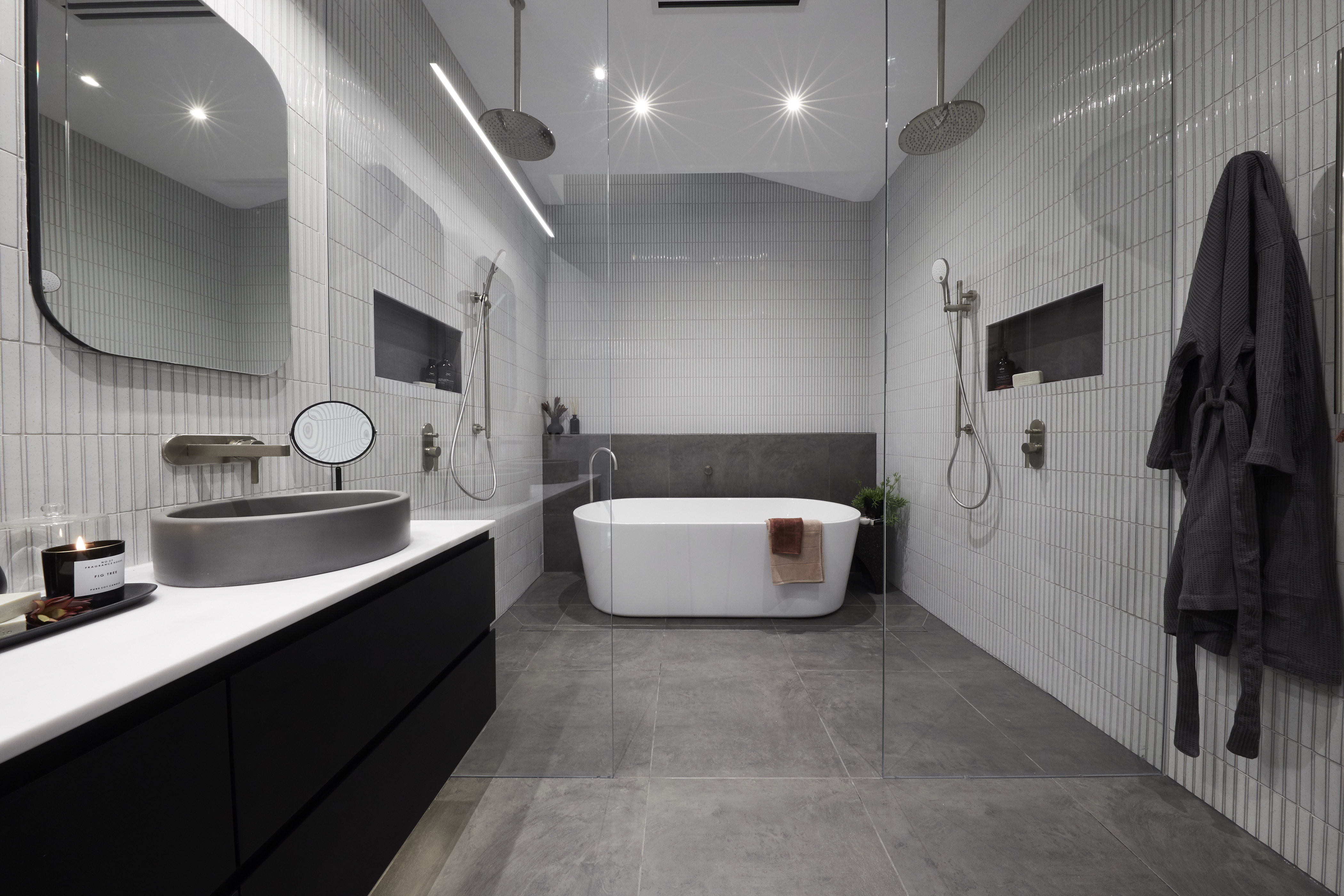Block Bathroom Design Styles

Block bathroom designs are gaining popularity due to their versatility and ability to create unique and functional spaces. They offer a clean, modern aesthetic and are well-suited for various bathroom sizes and layouts.
Minimalist Block Bathroom Design
Minimalist block bathroom designs prioritize simplicity and functionality. They emphasize clean lines, a limited color palette, and a focus on essential elements. The goal is to create a serene and uncluttered space that promotes relaxation.
- Color Palette: Neutral colors like white, gray, black, and beige are prevalent, with occasional pops of color for accents.
- Materials: Natural materials like stone, wood, and concrete are favored for their durability and understated elegance.
- Fixtures: Minimalist block bathroom designs often feature sleek, modern fixtures with clean lines and geometric shapes.
- Lighting: Natural light is maximized, and artificial lighting is often minimal and strategically placed.
Industrial Block Bathroom Design
Industrial block bathroom designs embrace raw and exposed elements, creating a modern, urban aesthetic. The focus is on showcasing the building materials and creating a sense of history and character.
- Color Palette: Darker colors like gray, black, and brown are prevalent, often paired with metallic accents like copper or brass.
- Materials: Exposed brick, metal, concrete, and reclaimed wood are commonly used materials, creating a rugged and industrial feel.
- Fixtures: Industrial block bathroom designs often feature exposed pipes, industrial-style faucets, and vintage-inspired fixtures.
- Lighting: Exposed lightbulbs and industrial-style pendants add to the raw and edgy aesthetic.
Scandinavian Block Bathroom Design
Scandinavian block bathroom designs are known for their clean lines, simplicity, and natural elements. They create a sense of tranquility and harmony, emphasizing functionality and natural light.
- Color Palette: Light and airy colors like white, beige, and light gray dominate, with accents of natural wood tones and pops of color.
- Materials: Natural materials like wood, stone, and ceramic are favored, often with a focus on sustainable and eco-friendly options.
- Fixtures: Scandinavian block bathroom designs typically feature simple, functional fixtures with clean lines and a minimalist aesthetic.
- Lighting: Natural light is maximized, and artificial lighting is often soft and diffused, creating a warm and inviting atmosphere.
Traditional Block Bathroom Design
Traditional block bathroom designs embrace classic elements and timeless elegance. They create a sense of sophistication and comfort, often drawing inspiration from historical architectural styles.
- Color Palette: Rich colors like navy, emerald green, and deep red are common, often paired with gold or brass accents.
- Materials: Traditional materials like marble, wood, and porcelain are favored, often with intricate details and decorative elements.
- Fixtures: Traditional block bathroom designs often feature ornate faucets, vintage-inspired vanities, and clawfoot tubs.
- Lighting: Crystal chandeliers, sconces, and other decorative lighting fixtures add to the elegant and traditional aesthetic.
| Block Bathroom Style | Defining Characteristics | Color Palette | Materials | Common Fixtures |
|---|---|---|---|---|
| Minimalist | Simplicity, functionality, clean lines | White, gray, black, beige | Stone, wood, concrete | Sleek, modern fixtures with clean lines |
| Industrial | Raw, exposed elements, urban aesthetic | Gray, black, brown, metallic accents | Exposed brick, metal, concrete, reclaimed wood | Exposed pipes, industrial-style faucets, vintage-inspired fixtures |
| Scandinavian | Clean lines, simplicity, natural elements | White, beige, light gray, natural wood tones | Wood, stone, ceramic | Simple, functional fixtures with clean lines |
| Traditional | Classic elements, timeless elegance | Rich colors, gold or brass accents | Marble, wood, porcelain | Ornate faucets, vintage-inspired vanities, clawfoot tubs |
Block Bathroom Materials and Finishes: The Block Bathroom Designs

Block bathroom designs offer a unique canvas for showcasing various materials and finishes. These choices significantly influence the bathroom’s aesthetics, functionality, and overall ambiance. This section explores popular materials used in block bathroom designs, their pros and cons, and ways to incorporate natural elements for a harmonious and inviting space.
Tile Materials and Finishes
Tile is a versatile and durable material commonly used in block bathroom designs. Its resistance to moisture and ease of cleaning make it an ideal choice for walls, floors, and shower areas.
The pros of using tile in block bathroom designs include:
- Durability: Tile is highly resistant to scratches, dents, and water damage, making it a long-lasting choice for high-traffic areas like bathrooms.
- Aesthetics: Tiles come in a wide array of colors, patterns, and textures, offering endless possibilities for creating unique and visually appealing designs.
- Easy Maintenance: Tile surfaces are relatively easy to clean and maintain, making them a practical choice for busy households.
- Water Resistance: Tile’s inherent water resistance makes it suitable for areas prone to moisture, such as showers and tubs.
However, tile also has some drawbacks:
- Cost: Tile installation can be expensive, especially for high-end materials or intricate patterns.
- Coldness: Tile surfaces can feel cold to the touch, especially in colder climates.
- Grout Maintenance: Grout lines require regular cleaning to prevent mold and mildew growth.
Tile Patterns and Textures
Tile patterns and textures play a significant role in defining the style and ambiance of a block bathroom.
Here is a visual guide comparing different tile patterns and textures commonly used in block bathroom designs:
* Subway Tile: This classic rectangular tile is a timeless choice for block bathrooms. Its simple yet elegant design complements various styles, from minimalist to traditional.
* Herringbone Pattern: This distinctive pattern adds visual interest and sophistication to block bathroom spaces. The alternating tiles create a dynamic and eye-catching design.
* Mosaic Tile: Mosaic tiles are small, individually crafted tiles that can be arranged in various patterns and designs. They offer endless possibilities for creating unique and intricate looks.
* Large Format Tile: Large format tiles, such as 12×24 or 18×36, create a clean and modern aesthetic. They minimize grout lines, giving the bathroom a sleek and spacious feel.
* Textured Tile: Textured tiles, such as those with raised patterns or uneven surfaces, add visual interest and tactile appeal to block bathrooms. They can create a sense of depth and dimension.
Stone Materials and Finishes, The block bathroom designs
Natural stone, such as marble, granite, and limestone, brings a touch of elegance and sophistication to block bathroom designs. These materials are known for their durability, beauty, and unique characteristics.
The pros of using stone in block bathroom designs include:
- Durability: Stone is a highly durable material that can withstand heavy use and resist scratches, dents, and water damage.
- Natural Beauty: Each piece of natural stone is unique, with its own variations in color, pattern, and texture, adding a touch of natural beauty to the bathroom.
- Timeless Elegance: Stone materials have a timeless elegance that can elevate the overall aesthetic of a block bathroom.
However, stone also has some drawbacks:
- Cost: Natural stone can be expensive, especially for high-quality materials and intricate designs.
- Maintenance: Stone surfaces require regular cleaning and sealing to prevent staining and damage.
- Porosity: Some stone materials are porous and can absorb stains, requiring careful maintenance and sealing.
Wood Materials and Finishes
Wood, a natural and warm material, can add a touch of rustic charm and organic warmth to block bathroom designs. While not as commonly used as tile or stone, wood can be incorporated strategically for a unique and inviting ambiance.
The pros of using wood in block bathroom designs include:
- Natural Warmth: Wood adds a sense of warmth and natural beauty to the bathroom space, creating a cozy and inviting atmosphere.
- Aesthetics: Wood comes in various grains, colors, and finishes, offering endless possibilities for creating unique and personalized designs.
- Sustainability: Using reclaimed or sustainably harvested wood promotes environmental responsibility.
However, wood also has some drawbacks:
- Moisture Sensitivity: Wood is susceptible to moisture damage and can warp or rot if not properly treated and sealed.
- Maintenance: Wood surfaces require regular cleaning and maintenance to prevent damage and maintain their appearance.
- Cost: High-quality wood, especially exotic varieties, can be expensive.
Concrete Materials and Finishes
Concrete, a versatile and durable material, is gaining popularity in block bathroom designs. Its industrial aesthetic and customizable finishes make it an ideal choice for modern and contemporary spaces.
The pros of using concrete in block bathroom designs include:
- Durability: Concrete is a highly durable material that can withstand heavy use and resist scratches, dents, and water damage.
- Versatility: Concrete can be molded and shaped into various forms, allowing for unique and customized designs.
- Industrial Aesthetic: Concrete’s industrial aesthetic adds a modern and edgy touch to block bathroom designs.
However, concrete also has some drawbacks:
- Porosity: Concrete is porous and can absorb stains, requiring proper sealing and maintenance.
- Coldness: Concrete surfaces can feel cold to the touch, especially in colder climates.
- Installation Complexity: Installing concrete requires specialized skills and knowledge.
Incorporating Natural Elements
Adding natural elements to a block bathroom design can create a sense of tranquility and harmony.
Here are some ideas for incorporating natural elements into a block bathroom design:
- Wood Accents: Incorporate wood accents, such as a vanity countertop, shelves, or a decorative mirror frame, to bring warmth and natural beauty to the space.
- Live Plants: Add live plants, such as ferns, orchids, or succulents, to create a sense of freshness and life in the bathroom. Choose plants that thrive in humid environments.
- Natural Stone: Use natural stone, such as marble or granite, for countertops, floors, or accent walls to add a touch of elegance and sophistication.
- Natural Lighting: Maximize natural light by incorporating large windows or skylights to create a bright and airy atmosphere.
- Organic Materials: Use organic materials, such as bamboo or rattan, for furniture or accessories to add a touch of natural texture and warmth.
The block bathroom designs – Block bathroom designs are known for their bold and minimalist aesthetic. The use of geometric shapes and clean lines creates a sense of order and sophistication. To add a touch of vibrancy to these modern spaces, consider incorporating turquoise paint for bathroom walls.
This refreshing hue complements the stark lines of block bathroom designs, bringing a calming yet energizing feel to the space.
Block bathroom designs are known for their clean lines and minimalist aesthetic, but they also present unique challenges when it comes to moisture control. To combat the potential for mildew, it’s crucial to select the right paint, and best paint for mildew in bathroom can help create a long-lasting and hygienic space.
With the right paint, block bathroom designs can be both stylish and practical, ensuring a comfortable and inviting atmosphere.